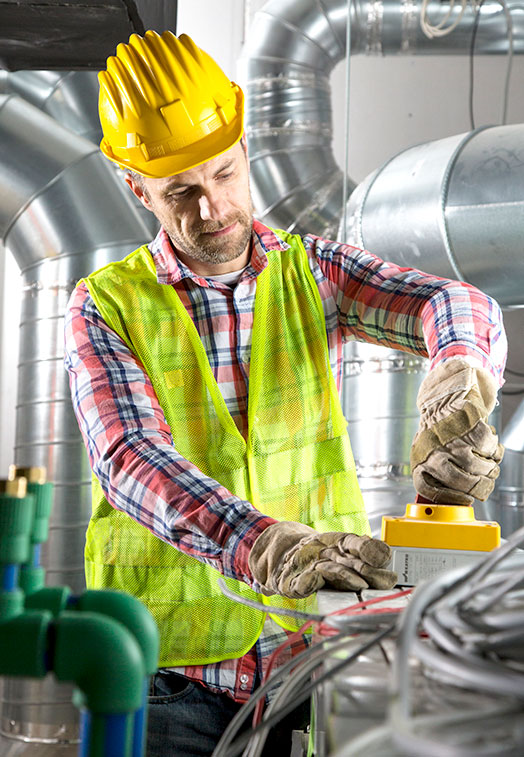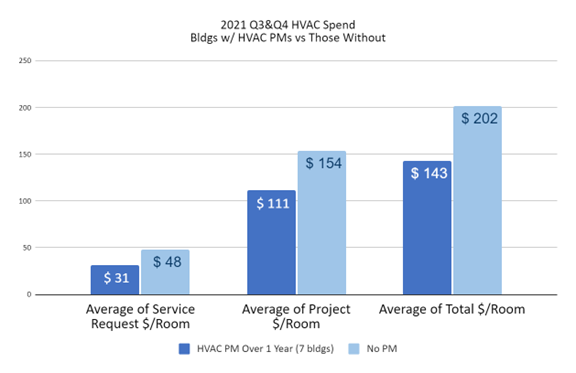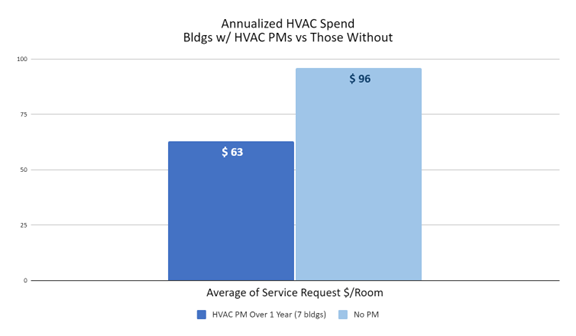Why Corporate Should Budget for Complex HVAC Equipment
Every $1 deferred in maintenance costs $4 of capital renewal needs in the future1, according to research conducted by CHD Healthcare. As operations-level decisions strive to remain in-budget throughout pricing increases caused by labor shortages and supply chain disruptions, there is no doubt projects that can be pushed off, will be. However, your HVAC system health is not an expense that should be deferred.
Both financial oversight and understanding your HVAC system are key to knowing when you should and should not push off maintenance and repairs. However, if a corporation does not allocate enough finances for their buildings to address preventive maintenance needs, deferred maintenance can occur. Because of this, commercial facilities – especially those with vulnerable populations such as healthcare and assisted living, should have its corporate/home office budget preventive maintenance for large, complex HVAC equipment instead of at the operational level. Here’s why.
Proper preventive maintenance budgeting and programs involving HVAC specialists for your system can help:
- Save overall costs in yearly budgets
- Create efficiencies in building operations
- Help maintain whole building health
Facilities tend to push off proper preventive maintenance because:
- It saves money in the short term, especially since inflation is driving up labor and parts costs
- People don’t have time in the now to focus on preventive maintenance
- It most likely won’t have an immediate impact on whole building health – until it does
This conflict between saving money in the short term and preparing for the long term is part of the reason why buildings struggle to budget correctly for HVAC preventive maintenance when planned for at the operational level. Let’s take a closer look.
Why HVAC preventive maintenance is pushed off
- Many operational-level employees in charge of this budget are bonused based off of community performance2, part of which takes into consideration what they don’t spend each month
- The corporation may not allocate enough money to fund the work
- Many preventive maintenance decision-makers lack education on why preventive maintenance is critical to whole-building health3.
Because of this, buildings oftentimes take the “less expensive” route of a lower monthly payment.
However, allowing large equipment such as the HVAC system to run-to-fail can have consequences, not only financially but for resident health and safety. For example, by allowing your HVAC system to break down, you run the risk of:

Carbon monoxide poisoning4
Increased energy bills
Unpleasant odors
Loss of comfort with facilities running too hot or too cold
Loss of business when word gets out that the building isn’t comfortable for residents
Early equipment replacement costs using savings which could have been spent elsewhere
“Nothing breaks down when it is 70 degrees and sunny – it’s more likely to hit you during weather when you need it most. I suggest at least a semiannual checkup, once before heating season and once before cooling season, to ensure your equipment is running effectively.”
Commercial HVAC preventive maintenance vs reactive service
As we compare preventive vs reactive maintenance costs, one conclusion becomes very clear: when it comes down to it, research trends clearly show that buildings with preventive maintenance plans will, on average, spend less money than those without.5 Based on the Jones Lang LaSalle preventive maintenance analysis, Determining the Economic Value of Preventive Maintenance, the “investment in PM not only pays for itself but also produces a huge return on the investment5” when taking into account discount rate, inflation rate, time horizon and nonproductive load time.
- Scheduled maintenance for important equipment
- Can catch issues before they become emergencies
- More planning overall & therefore more preparation for larger spend items
- More regular maintenance costs, but savings on emergency costs
- Ability to choose best service provider for your building
- Extends life of your equipment6
- As-needed basis
- Doesn’t allow budgeting for major breaks
- Emergency costs & service provider choice limited to whoever is available at the time
- High risk of equipment failure/breakdown7
- Shorter life expectancy due to overworking equipment
Assisted Living HVAC Preventive Maintenance vs Reactive Maintenance Case Study
Not convinced? – check the data. We were able to average the amount of HVAC spend for 7 assisted living buildings with HVAC preventive maintenance contracts and compare them to assisted living buildings without preventative maintenance contracts. Here are our findings:


What does preventive maintenance savings look like on a corporate scale?
By assuming the average facility is 100 beds, and the average corporation has 40 facilities, that means your savings may look more like this:
WITHOUT Preventive Maintenance
- Average spending equals about $384k a year
WITH Preventive Maintenance
- Average spending equals about $252k a year
This means you have the potential to save $132k a year simply by utilizing preventive maintenance*
Why large, complex project preventive maintenance should be budgeted by corporate/home office
So now you’re probably wondering why this is all relevant to you, and why you should add more to your plate concerning preventive maintenance. A relatively easy answer awaits: because corporate will already pay for equipment failure, due to it being a large, complex project. If facilities aren’t maintaining systems and those systems fail, you now have an expensive project on your hands that will impact you on the corporate level.

But, we get it – you’re busy, just like the operational level, if not more so. You’re wearing many different hats and it’s difficult to keep track of everything at once: how can you possibly add yet another thing on your plate? That is where a preventive maintenance program becomes beneficial.

How HVAC preventive maintenance programs can help
So, we have discussed the potential cost of neglecting preventive maintenance with a loss of efficiency, loss of building reliability and credibility, and a heavy impact of the longevity of equipment.

So, you’ll have oversight into your large, complex projects, which will enable more control over your budget and spend, and allow you to save money over the years – money that could be spent in other areas of your facility, or to hire additional personnel to help keep your facilities running.
Take Control of Your HVAC Spend!
Talk about preventive maintenance with your TELS representative today
Sources:
-
https://blog.plangrid.com/2019/06/the-high-cost-of-deferred-maintenance-and-how-to-avoid-it/#:~:text=According%20to%20research%20collated%20by,of%2Dthe%2Dart%20facility.
-
https://seniorshousingbusiness.com/hunt-is-on-for-executive-directors/#:~:text=Executive%20directors%20also%20typically%20receive,program%2C%20which%20makes%20payments%20periodically
-
https://home.akitabox.com/blog/deferred-maintenance-downtime/#:~:text=Deferred%20maintenance%20involves%20postponing%20maintenance,in%20the%20current%20budget%20cycle.
-
https://americanheatingandcooling.com/how-your-hvac-unit-can-affect-your-health/
-
http://cdn.ifma.org/sfcdn/docs/default-source/default-document-library/determining-the-economic-value-of-preventative-maintenance.pdf?sfvrsn=2
-
https://www.carrier.com/residential/en/us/products/air-conditioners/how-long-do-air-conditioners-last/
-
https://www.getmaintainx.com/blog/equipment-failure-common-causes/



